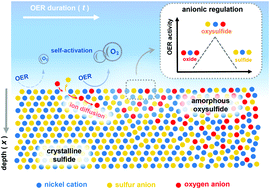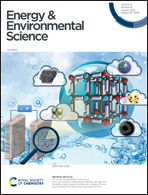An anionic regulation mechanism for the structural reconstruction of sulfide electrocatalysts under oxygen evolution conditions†
Abstract
Sulfides have long been regarded as a high-performance electrocatalyst for oxygen evolution; yet the actual structure of their active sites under working oxygen evolution conditions remains controversial. Herein, an anionic regulation mechanism is revealed on sulfide electrocatalysts under working oxygen evolution conditions. Specifically, the sulfides on the surface transform into oxysulfide by means of oxygen and sulfur anions leading to the co-construction of a multi-anionic structure. The multi-anionic structure regulates the electronic structure of the active sites and further enhances their electrocatalytic activity. More importantly, the in situ formed oxysulfide exhibits unexpected stability under working oxygen evolution conditions, manifesting the surface oxysulfide as the actual active site for oxygen evolution electrocatalysis. This work propels the fundamental understanding of the surface reconstruction and actual active sites of sulfide oxygen evolution electrocatalysts and inspires rational electrocatalyst design on advanced multi-anion compounds.



 Please wait while we load your content...
Please wait while we load your content...